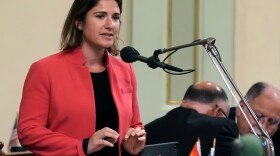T cells that reside in human tissue are little watchdogs that live in your lungs, your skin or your gut, to name a few. When they see a diseased or malignant cell, they kill it.
Unfortunately, they have a tough time with tumors. That’s a fight they usually lose.
But biologists at UC San Diego have found a way to give added energy to these cells. In the lab, these modified T cells have slowed the growth of tumors in mice and, in some cases, eliminated them.
“It’s like we found a battery pack for a T cell to keep their engine running a bit longer. And that ‘bit longer’ seems to be working in mouse models of cancer and hopefully we can translate this to human studies,” said UCSD postdoctoral fellow Miguel Reina-Campos.
He was the lead author of a paper on the research, published in the journal Nature.
Reina-Campos said the problem with tumors is humans have not evolved to combat them because, until very recently, we didn’t usually live to an age when tumors become prevalent. Also, a tumor is a very hard place for the immune system to operate.
“Imagine a tumor as a broken up, destroyed city that has toxic fumes and toxic gasses leaking everywhere and there is no food. So when T cells arrive there, the battery that powers their functions becomes depleted very fast,” he said.
But UCSD researchers identified some elements that can sustain the energy of T cells and allow them to survive and keep fighting tumors in that hostile environment. And they come from an interesting place.

Tissue-resident T cells might be soldiers for the immune system, but they have a side hustle. Making cholesterol. That cholesterol does not make the T cells stronger, but some elements produced in the same pathway can help a lot.
“In the process of making cholesterol, these cells make lots of other intermediates. And those intermediates were what were charging the battery packs of T cells in tissues,” said Ananda Goldrath, a biology professor at UCSD who runs the lab that conducted the T cell research.
Goldrath said Coenzyme Q is one of the elements that helps make T cells stronger. Researchers discovered that a fungal byproduct called Zaragozic acid changed the cholesterol pathway to increase the creation of Coenzyme Q.
“One way of thinking about it is there’s a river, and at the end is cholesterol but there are all these little side streams that exist as well. And it turns out it’s the side streams that are making the molecules that the cells want,” Goldrath said.
Human trials may be a ways away but researchers are already thinking about developing a drug that can create this process in humans. In the lab, Goldrath said they tested melanoma tumors and colon cancers.
Reina-Campos, a native of Barcelona, notes that Zaragozic acid was a Spanish discovery, named for the city of Zaragoza.






